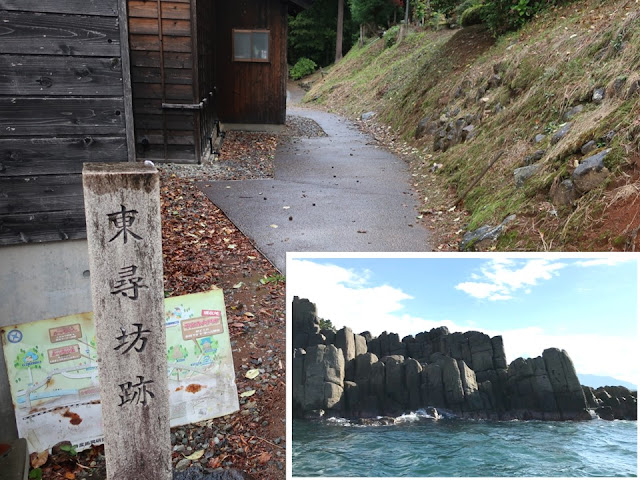Heisenji (Fukui prefecture, central Japan) was established in 717 as a gateway to the worshipped mountain “Hakusan”. There were six thousands of priest dwellings in its primetime in the medieval era; it was also a warring group which had priest soldiers. However, it is a calm and sacred place now. About “Mahoroba”, I submitted an application for photography and uploaded photos.
平泉寺(福井県勝山市)は、717年に信仰の山・白山への登山口として開かれました。戦国時代には六千の坊院が建ちましたが、1868年の神仏分離令を受け、白山神社と改めました。御師が信者を募るのではなく、荘園や寺領からの初穂米などで経営されてきたようです。僧兵を擁した戦闘的な集団でもありましたが、今は静かで、神聖な空気が漂います。なお、「まほろば」は許可を申請し、写真を撮影し掲載しました。
Hakusan-Heisenji
Shrine、平泉寺白山神社
I went up the stairs to the shrine. The building on the left is one of priest dwellings.
平泉寺白山神社へ上っていきます。左は坊院の一つ、顕海寺。
There is grass beside the road; it has a legend. A horse of a votive picture board in the shrine got out of the board every night. It ate crops of the village, therefore, the shrine made the grass field for the horse. The grass is not cut even until now. The legend entertains visitors.
進んでいくと、「飼葉料」があります。「桃山時代に、今も拝殿の内に掲げられている絵馬から夜中に駿馬が抜け出して村民の田畑の作物を食い荒らし、困った当社は此処を馬の飼葉料としたとの伝説があり、現在も草を刈り残している」と書かれています。ストーリーは訪れた人々を楽しませますね。
After walking a bit, you can find a pond. The founder of the shrine “Taicho” found a spring on the way to Mt. Hakusan. He met the great Hakusan Deity, and the deity talked to him that here was a place where a deity stayed. So, Taicho established the shrine here; it is Hakusan-Heisenji Shrine.
少し進むと、御手洗(みたらし)池。717年に、泰澄(たいちょう)大師が白山登拝の途中に泉を発見。すると、白山の大神が現れ、「神明遊止の地なり」とのお告げがあり、当地に社を建てたとのことで、平泉寺発祥の地とのことです。
There is a distinctive tori gate on the way to the hall of worship.
特徴的な鳥居をくぐって、拝殿へと進みます。
Beautiful moss covers the ground along the approach.
参道沿いには、美しい苔が広がります。
I walked beside the hall of worship, and reached the main hall.
拝殿の横を通って、本殿に参ります。
The main hall in center was rebuilt in 1795. There are two other halls beside the main one; three deities of Hakusan are enshrined.
中央の御本社は1795年に再建されました。左右に別山社、越南知(おおなむち)社を配し、白山の三山の神を祀っています。
The rear shrine (located behind the main shrine) is a deity of safe childbirth.
奥社の三之宮は安産の守護神です。
Pilgrims offered their hand-copied sutra to the small hall. They visited sixty-six places across Japan on foot and did it, so it’s a long-term pilgrimage. They had various thoughts and visited the hall above, I guess. Even in Yoshino’s diary which I’m reading, a villager asked a village head to issue a passport to go on the pilgrimage in 1809, however, he was rejected unhappily. The stones beside the approach are Buddhist statues.
奥社への途中に、六十六部の納経所があります。平泉寺は、全国66カ所の霊場に大乗妙典(法華経)を奉納する霊場の一つです。さまざまな思いを持ち、村を飛び出した人々が訪れたと思います。私が読んでいる江戸時代の名主の日記(吉野家日記)にも、六十六部に出たいと名主に申し出た人がいます(1809年)が、道中手形は発行してもらえませんでした。道端には、石仏が。
There is a memorial tower for pilgrims at the entrance of the main approach. It was rebuilt in 1890.
参道の入口には、「大乗妙典六十六部日本廻国供養塔」が奉納されています。1890年に再建されました。
The small shrine above is also near the memorial tower. It is dedicated to the deity of fire or making a fire, which is worshipped as a deity of marriage.
参道の入口には、結(むすび)神社があり、御神体は隕石と伝えられています。記紀神話における火の神、火産霊(ほむすび、火を産む神)とも書かれていて、縁結びの神様として信仰を集めています。
The is a ruin of a priest dwelling “Toujin-bou”. The name came from the one of a legendary priest; he was deliberately murdered at the rocky beach (lower right) which is also named "Toujin-bou”. The beach is a popular tourist spot now.
東尋坊跡もあります。福井県北部の名勝・東尋坊(右下)の名は、謀略で転落死した僧・東尋坊の名に由来するともいわれています。
Official website: https://heisenji.jp/ (in Japanese), accessed in May, 2024
History Hall Mahoroba、白山平泉寺歴史探遊館まほろば
The history hall shows us mountain worship and excavated articles of Heisenji. The photos below were taken under the permission of the hall and are uploaded.
ここでは、山岳信仰と、平泉寺の発掘物を展示しています。次からの写真は、館の許可を得て、撮影・アップロードしました。
Mountain worship in Japan and in Hakusan is exhibited by panels and videos on the right side of the room.
エントランスから向かって右側には、山岳信仰、白山信仰がパネルや映像で紹介されています。
Mountain worship and Mt. Hakusan、山岳信仰と白山
It is written,
- Buddhism, Taoism and Shenxian thought (immortal mountain wizard in Taoism) were introduced to Japan in the 5th and the 6th century. It became popular to practice among mountains in order to acquire superhuman abilities.
- In around the 10th century, Japanese mountain asceticism “Shugen-dou” was developed under the influence of esoteric Buddhism which prioritizes on training in mountain. Mt. Hakusan became an important training place.
- In the Edo period (1603~1868), Mt. Hakusan was called the three great sacred mountains along with Mt. Fuji and Mt. Tateyama; many people worshiped it.
Mountain worship is something mysterious, but I got it!
○5・6世紀ころ、大陸から仏教や道教、神仙思想が日本に伝わり、山に入って修行して呪力を身につけるための山林修行がさかんになりました。
○さらに、平安時代には、山中での修行を重んじる密教の影響もうけて、修験道が発達していきます。白山はその代表的な場の一つとなりました。
○江戸時代には、富士山・立山とともに日本三霊山と呼ばれ、より多くの人びとに崇め親しまれました
と書かれています。なるほど!
On the ways to Mt. Hakusan, there are training spots such as falls or rocky places. There are three starting points, and Heisenji is one of them. It takes three days to reach the summit.
白山山頂への道「禅定道」には、滝や岩場などの修行場があります。登拝の拠点は馬場と呼ばれ三カ所あります。平泉寺はそのひとつ。二泊三日で白山に登頂できる場所にあります。
Heisenji was established in 717. During the internal wartime in around 1500, Heisenji had eight thousand priest soldiers, forty-eight shrines, thirty-six halls and six thousand priest dwellings. However, farmers attacked Heisenji and burned its buildings in 1574. Although some buildings were rebuilt, the ground was one-tenth of the one before. In 1868, an ordinance to distinguish Shinto and Buddhism was issued. Heisenji abolished its temple's name and became Hakusan Shrine. It has complicated history.
平泉寺は717年の創建、戦国時代には48社、36堂と六千の坊院が建ち、八千の僧兵を擁したそうです。しかし、1574年に地元農民らの一向一揆の攻撃で全山が焼失、後に再興されましたが、境内は元の1割ほどになりました。その複雑な歴史は、司馬遼太郎が「街道をゆく」で書いています。明治初年には神仏分離令にもとづき、寺号を廃して、白山神社と改めました。
Excavated articles are displayed with panels on the opposite side. Those shows us priests’ life and activity.
エントランスから向かって左側には、パネルとともに発掘物が展示されています。発掘品から僧侶たちの暮らしや活動が分かります。
The priests’ living quarters、坊院
It is said there were 6,000 priest dwellings, and from 700 to 800 places have been already discovered. It is presumed that a standard priest dwelling was 30-meter square, and around ten people (including soldiers during the ancient era) lived. The building was surrounded by earthen walls. The photo above shows an excavation site.
平泉寺には6000の坊院があったと伝えられていますが、既に700~800カ所が確認されています。標準的な坊院は約30m四方で、土塀に囲まれ、10人前後が暮らしていたと推定されています。古代の平泉寺は、僧兵をもち、源平の争いにも参加したそうです(上は発掘場所の写真)。
Ladle and so on were found, which made me feel their daily life.
汁を混ぜたりすくったりする汁杓子も見つかっていて、彼らの暮らしを感じさせてくれます。
Stoves were also found because it is a cold area. Tea utensils tell us they enjoyed tea ceremony.
寒い場所ですから、火鉢や行火(あんか)も見つかっています。茶道具も見つかっていますよ。
A piece of crystal prayer beads (left) was unearthed. The white porcelain Kannon statue was probably made in Jingdezhen, China. It is presumed to be ornamented in a guest room. It’s fun owning excellent items.
水晶の数珠玉が出土しています。清白磁の観音像は、景徳鎮で作られた物と思われ、座敷飾りなどとして使われたと考えられています。良い品をもつのは楽しみですね。
https://www.city.katsuyama.fukui.jp/heisenji/mahoroba/ (in Japanese), accessed in May, 2024
Fukui Prefectural Dinosaur Museum is near Heisenji. It is very popular museum; staff got interviewed for TV when I visited.
大人気の福井県立恐竜博物館が近くにあります。訪問時は取材が入っていました。
Old stratum (colored area in the map above) appears in the region, so it’s easy to find fossils. Dinosaur became a ruler because of its giant body and power; human became a ruler because of intelligence. However, the earth overwhelms both; we cannot rebel it. I felt it strongly in the museum.
北陸には古い地層が露出しています。恐竜が見つかりやすかったのですね。恐竜は体の大きさで支配者になり、人間は知能で支配者になりました。でも、展示物と拝見していると、地球の力には抗えないものだと、強く強く感じました。
We can see the laboratory through the windows.
調査をしている様子も拝見できます。
Visited in October, 2023
Previous post (museum in the neighboring
city): Ono
Historical Museum、大野市歴史博物館
Next post (ruin in the medieval era in the same prefecture): Ichijodani Asakura Family Site、一乗谷朝倉氏遺跡

























Comments
Post a Comment